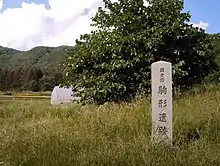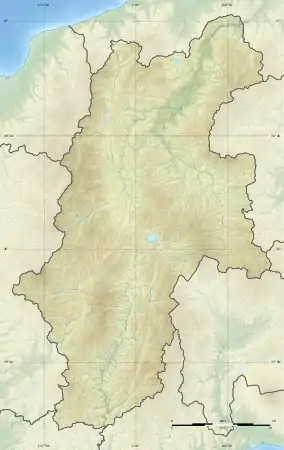Komagata ruins
Komagata Ruins (駒形遺跡, Komagata iseki) is an archaeological site containing the ruins of a Jōmon period settlement located in what is now part of the city of Chino, Nagano in the Chūbu region of Japan. The site was designated a National Historic Site of Japan in 1998.[1]
駒形遺跡 | |
 | |
 Komagata Ruins  Komagata ruins (Japan) | |
| Location | Chino, Nagano, Japan |
|---|---|
| Region | Chūbu region |
| Coordinates | 36°02′22″N 138°11′21″E |
| Altitude | 910 m (2,986 ft) |
| Type | settlement |
| History | |
| Periods | Jōmon period |
| Site notes | |
| Ownership | National Historic Site |
| Public access | None |
Overview
The site is located at an altitude of 910 meters on a well-watered plain south of Mount Kirigamine and appears to have been inhabited continuously from the Japanese Paleolithic period through the Heian period. The ruins covered by the National Historic Site designation include 106 pit dwellings from the middle of the early Jōmon period through the middle of the late Jōmon period (9000 to 4000 years ago). This settlement was located near high quality deposits of obsidian, and was a center for the production and trade of ornaments and tools made from this volcanic glass. The site has been excavated 15 times since 1961.
The site is marked by a stone monument, but there are no facilities at present for visitors. It is located approximately 15 minutes by car from Chino Station.
References
- "駒形遺跡" (in Japanese). Agency for Cultural Affairs.
External links
- Chino city official site (in Japanese)